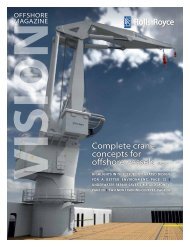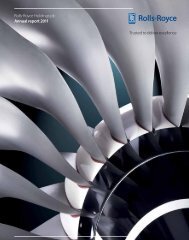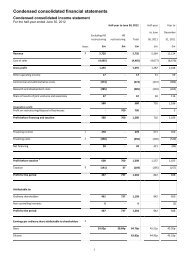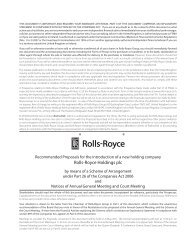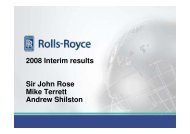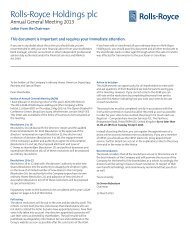View transcript - Rolls-Royce
View transcript - Rolls-Royce
View transcript - Rolls-Royce
You also want an ePaper? Increase the reach of your titles
YUMPU automatically turns print PDFs into web optimized ePapers that Google loves.
<strong>Rolls</strong> <strong>Royce</strong> Investor Briefing<br />
Farnborough Airshow – 20 July 2010<br />
Dan Korte<br />
President, Defence Aerospace<br />
Good morning. Talk to you just a little bit about the defence portion of the<br />
business, spend a few minutes. We’ll walk through a little bit of an<br />
overview, and mark our position first, and we’ve got three other sections<br />
we’ll go through. So, first a little bit about the market. And you can see<br />
from the chart here, of course the defence business is still dominated by the<br />
US marketplace.<br />
That’s the largest market in the world. But there’s a good spread across the<br />
rest of the globe, and, actually, the dynamics are changing around the world<br />
and where some of that spend is taking place, and we’re pretty wellpositioned<br />
to take advantage of that growth. But that kind of gives you the<br />
spread.<br />
Currently, we serve 160 armed forces in 103 countries. So, it is a very<br />
broad portfolio in defence. On the other side of the chart there, you see the<br />
breakout of where the money gets spent. Of course, most of the attention<br />
seems to get focused, often, on the new procurements and what’s happening<br />
in acquisition, but the largest portion of the spend, actually is in the<br />
operations and maintenance part of the business.<br />
So, as you’ve heard the two prior speakers, Mark and Mike, speak about the<br />
importance of the services business - that rings true in the defence portfolio<br />
as well. That piece of strength continues to endure and continues to serve us<br />
well. This is just a quick graphic of some of the things that are happening in<br />
the defence portfolio.<br />
Mike talked about first flights. Actually, we’ve had six first flights just in<br />
the defence portfolio alone over about the last year. Some of the major ones<br />
include the first flight, the first vertical hover and landing of the lift system<br />
on the Joint Strike Fighter. Very proud of that. The first flight of the A400<br />
which, if many of you were at the show over the last day or so, over the<br />
weekend in RIAT, you could see the A400M flying.<br />
We’re very proud of the accomplishments there. Also, the first flight of the<br />
Mantis which is an unmanned vehicle - a UK programme that also uses our<br />
engine. And we had three others as well in the helicopter business all<br />
around our CTS800 engine. So, a lot of investment in the future going on in<br />
the defence portfolio today, just as in the civil market. It’s very balanced<br />
from that standpoint.
We’re also spending a lot of time developing the services opportunities for<br />
the markets, as they’re evolving. Some customers are moving more towards<br />
a long term service model. Some are trying to figure out what the approach.<br />
The one dynamic that’s of interest in this<br />
market, to me, particularly, is that, as budgets get constrained, and as<br />
people run into budgetary issues, they actually tend to look more and more<br />
at the “TotalCare” model, the long term service models, because they’re<br />
actually usually more cost efficient than their own approach.<br />
Because we get to spread the cost, we get to take the efficiencies across that<br />
broad portfolio.<br />
I mentioned the breadth and depth of customers we have around the world.<br />
When we can leverage the spares pipeline and we can leverage the<br />
infrastructure we have in our logistics train, and make sure that we are<br />
servicing all of our customers, we can do it a lot more cost effectively. So,<br />
they’re all looking at availability contracts, just as Mark described in civil.<br />
We can guarantee that mission criticality – that they will have the engine<br />
when they need it for their mission, anywhere around the world, 24/7. And<br />
they can have it to produce the capability that they need. It’s all well and<br />
good to have a large pipeline of spares, but if they don’t have the right<br />
engine at the right time and the aircraft isn’t able to eventually perform the<br />
mission – so it turns into reliability of the product as well with guaranteed<br />
reliability in the defence market, we can provide that kind of service.<br />
Again, it gives our customer the confidence so they can complete their<br />
mission. To do that, we continue to invest in our own capabilities, One of<br />
the nice things about the high level of integration across the <strong>Rolls</strong> <strong>Royce</strong><br />
group, is that we get to leverage each other’s strengths. So, actually the first<br />
operation centre started up in Derby in the civil business. We now have an<br />
operation centre in defence in Bristol that’s running 24 hours a day, 7 days<br />
a week that’s monitoring numerous customers around the world and all<br />
their products.<br />
And, as we learn things about the defence business, we get to feed that right<br />
back into Mark’s business as we learn things and how to run our operation<br />
centre more efficiently. So, we improving that, we’re improving our<br />
response times, we’re broadening our capabilities, we’re putting more<br />
engine types into that kind of Total Care solution, and that’s helping all of<br />
our customers.<br />
So, this is just a glimpse of the current portfolio today, inside of defence. It<br />
shows how we break out. You can see two key numbers very quickly –<br />
52% of the defence portfolio is service, and also, 52% is in the transport<br />
segment. So, you can see transport and ISR are two very strong market
segments. You’ll hear our customers talk a lot about that.<br />
We also have a strong presence in combat, but it’s a nice, balanced<br />
portfolio, whether you’re looking at it from the standpoint of development<br />
versus long term care, or whether you’re looking at it from market segment.<br />
If you exclude the commercial, the civil helicopter business, we’ve got<br />
about 18,000 engines in service around the world. A nice, broad portfolio.<br />
So, that’s where that 52% service opportunity comes from. Good<br />
positioning on both fixed and rotary wing. Our STOVL experience, our<br />
ability to create aircraft that can take off in very short runway situations,<br />
and land vertically, i.e., the LiftSystem for the Joint Strike Fighter is a<br />
technology that only <strong>Rolls</strong> <strong>Royce</strong> has. No other company in the world can<br />
do that.<br />
So, we talk about Blue Ocean kind of positions. I mean, that’s one of them<br />
that we have today, and it goes all the way to, really, the Harriers, but it<br />
goes up through technologies like what we have on the V22-Osprey, and<br />
then into that LiftSystem. If you get out to the show, take a stop by the<br />
stand and look at the technology that goes into that – the swivelling of the<br />
nozzles, and what we can do with that lift, and the amount of thrust we can<br />
put through that fan is unprecedented in the industry.<br />
And the ability to essentially get the exact same thrust out of an engine, and<br />
put it through a Lift Fan with no losses, essentially. And thrust is really a<br />
feat of physics that is unmatched by anyone in the industry.<br />
And then we’re a leader in the transport segment. It’s an incredibly robust<br />
piece of the market today. Transport is maybe one of the things that, it’s not<br />
the most talked about portion of the portfolio, but it’s needed day in and<br />
day out in the types of missions that our customers are doing, and that’s a<br />
very strong part of our portfolio.<br />
We’ll talk about market outlook. So, first, a little bit on trends in defence<br />
aerospace. Indeed, global defence budgets are under pressure in a number<br />
of markets, but there’s increased spending power in a lot of emerging<br />
markets – places like India, Saudi Arabia, South Korea – all very robust<br />
markets that are spending at high percentage points of their GDP on<br />
defence procurement.<br />
Who would have thought three years ago, that India, in the last three years,<br />
would have spent $27 billion on defence acquisitions. Those are the types<br />
of growth opportunities that, quite frankly, are offsetting some of the<br />
budgetary pressures in other parts of the world. Opportunities for services<br />
because of the sustained deployments.<br />
The deployments that are happening today in Afghanistan are driving the<br />
need to service all those aircraft, all those rotary wing platforms that are out
there, but are also driving a lot of transport requirements. That’s really a,<br />
you know, you see that around the world, and we tend to focus on places<br />
like Iraq and Afghanistan, but there’s actually large transport demands in<br />
Africa and a lot of other portions in the world that also drive our business.<br />
And then, finally, one of the trends in our business is, research and<br />
technology dollars, and I say dollars correctly, because most of them are<br />
still coming out of the US. A lot of them are shared now, which is both a<br />
good and a bad thing.<br />
From a negative standpoint, we have to come up with the capital to invest<br />
in future programmes, but from a good standpoint, we can control more of<br />
the intellectual property and have that IPR in our own portfolio, so we can<br />
capitalise on that in the future much like civil is able to capitalise on a lot of<br />
their IPR. So, it’s a little bit of a change in the marketplace and how<br />
research and technology is happening today, and I’ll come back to R&T a<br />
little bit later.<br />
If you look at just the propulsion market – this gives you a snap shot of<br />
what it looks like around the world. It’s about a $450 billion market over<br />
the next 20 years. We understand the customer requirements very well over<br />
the next 10 years.<br />
We’ve got a very good insight into where this market is moving. Cost<br />
reduction is actually driving some opportunities for us. As I mentioned<br />
earlier, as customers look to find ways to improve the way they do their<br />
business, many times they come to <strong>Rolls</strong> <strong>Royce</strong> because we can do it more<br />
efficiently, we can do it more effectively. And then the trends where the<br />
growth<br />
markets are shifting. I mentioned Indian as an example. Brazil is another<br />
interesting part of the world right now. They’re investing quite heavily in<br />
the defence marketplace, and looking for new capabilities. So, let’s talk a<br />
little bit about the priorities in the sector. First in the transport and ISR<br />
market. Our strongest market – the backbone, today, is between the<br />
AE2100 family of engines and the T56, which drives a lot of the current<br />
fleet.<br />
There are over 7,000 T56 engines in service today around the world. One of<br />
the nice things about this market – we own the market today and we<br />
continue to protect the market as we move forward. So, for instance, in the<br />
T56, we’re just finishing development of an upgrade to that engine.<br />
The 3.5 is going to be the latest standard of that engine. Just a couple of<br />
facts and figures about it – the engine saves 12.5% fuel burn off the prior<br />
standard of engines, and that’s very important to our customers. It lowers<br />
the operating temperature of the turbine, which gives you improved<br />
reliability and increased life. It actually, at the same time it does those two<br />
things, it gives increased performance to our customers.
So, you’ve got those 7,000 engines out there in service today, that we have<br />
a cost effective upgrade to this 3.5 standard that’ll help them solve some of<br />
the near term problems they have. Every upgrade that occurs from the<br />
current standard to a 3.5 T56, is the equivalent of taking 52 automobiles off<br />
the roads today, just in the amount of fuel that it saves.<br />
So, it’s a nice solution set for our customer, but it helps us protect our<br />
current markets from the competition, and that’s the thing we continue to<br />
do. We invest in new markets and new opportunities, but we also protect<br />
our current markets by continuing to innovate, continuing to drive new<br />
technology and new capability into those platforms. Also, the TP400, for<br />
the A400M – the entry into service is scheduled for 2013.<br />
We’ve made very good progress in the flight test schedule on that<br />
programme. The engine is performing very well today. We’re extremely<br />
happy with that as the development continues, and we’ll continue to work<br />
very closely with the customer to make sure we’re responding to any issues<br />
that might come out of the flight test programme, but, to date, we haven’t<br />
seen any significant issues in that flight test programme.<br />
Combat engines – first is the LiftSystem, as I mentioned earlier. We’ve got<br />
four of those installed in flight test. They’re performing exceptionally well,<br />
and we’re extremely happy as we continue to develop that product for that<br />
marketplace.<br />
There’s a lot of customers that need vertical lift in their capability portfolio<br />
– the US Marine Corps being one of the strongest customers for that –<br />
they’re completely reliant on this particular engine variant for their mission<br />
in the future.<br />
The next one is the F136 engine for the JSF, often referred to as the<br />
alternate engine. It obviously gets a lot of press these days. We’re teamed<br />
with General Electric to deliver this engine. We have 40% of this particular<br />
engine programme. We’ve got three engines delivered. We’ve got three<br />
more on the way that are going to deliver this year. So far, we’ve<br />
accumulated over 850 hours of test time on the engines – performing very,<br />
very well. Every report card we’ve gotten from our customer – the US DoD<br />
has a process where they give contractor performance assessment reports<br />
out to industry.<br />
Everyone has been exceptional or very good in their scoring criteria, so it’s<br />
actually, contrary to what you might hear in certain press, it’s performing<br />
very well in the development programme.<br />
And, one of the things I think is a high point for this alternate engine, and<br />
it’s the same point that Mark was making on the Trent 700 – this is a<br />
custom design solution for the Joint Strike Fighter. Between GE and <strong>Rolls</strong><br />
<strong>Royce</strong>, we have designed this engine. It’s a highly integrated engine with a<br />
Joint Strike Fighter.
Unlike our competition which has taken an engine from another aircraft and<br />
modified it for use in the Joint Strike Fighter, we’ve designed one to be<br />
highly integrated with this platform. So, we actually have a larger fan,<br />
we’re able to create some additional growth opportunities for the customer<br />
in the future if they need it, but it’s a form fit and function replaceable<br />
engine.<br />
You can put either one in, but this one will offer a lot more growth<br />
capability in the future, so it’s one of the things that the customer is worried<br />
about mission critical needs are very attuned to. We continue to have strong<br />
support in congress, but we’ll have to wait and see how it turns out. We had<br />
a nice support where they asked the House Armed Services Committee to<br />
put in $485 million for this alternate engine.<br />
There was a full house vote a few weeks back that you might have heard<br />
about, where they affirmed the need to continue the alternate engine<br />
programme, but they’re now getting ready to go into conference before<br />
long, and we have to work through that process and continue to work with<br />
our customers to deliver this need. The EJ200 – operating on the Euro<br />
Fighter Typhoon.<br />
Over 150,000 hours in service – continues to perform very well, and we<br />
also see the ability to export this engine into other markets around the<br />
world. Technology – one of the things that we do across <strong>Rolls</strong> <strong>Royce</strong>, but is<br />
also a very strong push for us in defence, is leveraging our technology<br />
centres around the world. It’s always nice to use other people’s money to<br />
work on your research and technology, and so we look at universities as a<br />
strong place, and we also invest in the universities, but it’s joint investment<br />
in research and technology to drive propulsion.<br />
The US government, as I mentioned earlier, in addition to other<br />
governments around the world, continue to invest in research and<br />
technology. So, we take that, we leverage that, and we can leverage it<br />
across our business because we are a broad based power systems company.<br />
We can take the best of technologies from around our business, and use<br />
them as appropriate, within export control laws, of course.<br />
One of those technology thrusts, right now, on the one end I’d like to spend<br />
just a minute or two on, is Advent. Advent is a US-led technology<br />
programme, really trying to develop the next generation in engine<br />
technologies that can be used on numerous aircraft types. It’s the<br />
cornerstone of all R&T that’s going into propulsion in the word today.<br />
It’s driving for 25% greater fuel efficiency in aircraft propulsion. The way<br />
it does that, and what makes it so unique, is that it’s able to vary,<br />
essentially, the configuration of the engine to the type of mission you’re<br />
doing at that point in time. So, it can be a very efficient engine when you’re
in cruise or loitering in a platform, but when you need high capability,<br />
when you need<br />
a lot of thrust in, maybe, a combat environment, it’s able to, essentially,<br />
morph into a different type of engine using a variable fan plate and variable<br />
core technology to do that. There was the phase 2 investment, there was<br />
only one winner of that contract in the US, and that was <strong>Rolls</strong> <strong>Royce</strong>.<br />
<strong>Rolls</strong> <strong>Royce</strong> beat both General Electric and Pratt and Whitney to get the<br />
lion share of the funds, to do a full engine demonstrator in the phase 2<br />
Advent programmes. We think we’ve got some pretty nice technology here,<br />
that’s going to take us into that next generation of engine technology. So,<br />
we talk about today, this is out into the next decade of military needs, and,<br />
again, that technology, one of the things we’re working very closely with<br />
our US customer on, is the exportability of that technology, so some if it<br />
can find its way into commercial marketplaces as well, into Mark’s<br />
business.<br />
Again, that tight linkage between all of our businesses is very crucial in<br />
<strong>Rolls</strong> <strong>Royce</strong>, and one of the underpinnings of our success. That investment<br />
continues to occur. I was just speaking to some customers yesterday, and<br />
following this phase 2, there’ll be a technical maturation programme, and<br />
the US military is very committed to make that programme happen.<br />
So, we look forward to that. So, in summary, we’ve got a very wellbalanced<br />
portfolio across a number of segments of the defence marketplace.<br />
We support a very broad customer base as I mentioned.<br />
We’ve got good market positions in the markets that we serve today. And,<br />
going forward, we’ve got a nice balance between development, original<br />
equipment manufacturer, production of engines today, and of aftermarket<br />
solutions and after market service revenue.<br />
We have long product lives, and we’ve got a strong mix of both and<br />
established engines in many of those key markets. And the services<br />
business continues to drive a substantial revenue inside the sector. So, with<br />
that, I’d like to turn it back over to Mike Terrett. I think he’s going to wrap<br />
us up. Thank you.




